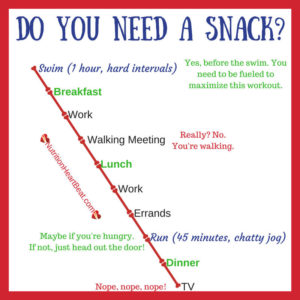Who, what, when, where, and why an athlete should – or shouldn’t – snack!
You’ve got a workout coming up and you’re hungry. Should you have a snack?
It depends on the type of workout, how soon it starts, and the goal of the snack!
Who should eat snacks
If the workout is long or you’re hungry, consider a snack. Athletes with a workout requiring carbohydrate, so strength, power or speed workouts, should either snack or work out when they still have energy from their last meal. Athletes who have a breakthrough workout, or those endurance athletes who just have a long workout and will need extra food during the workout anyway should definitely have snacks. Anyone recovering after a workout where the next meal is more than an hour out should have a snack.
What and when should they eat?
Athletes have several options here, depending on time frame and goals of the training session.
- Carbs only: This is appropriate very close to an intense workout when one needs fast energy
- Carb, protein:This is useful for long, slow or tempo workouts where energy needs are important but so is not being hungry. This should also be consumed at least 30 minutes before starting to train.
- Small meal: Useful for a training session a couple of hours away, or for endurance athletes working on gut adaptation for race day. Ultra-endurance racers (ultra-marathon, randonneurs and athletes training for excursions) also need this type of snack because of the sheer amount of calories they’ll burn while training.
- Fluids only: Short, incredibly intense workouts OR any hot workout less than about 90 minutes.

Where should the snack should be consumed?
It depends on the type of workout.
- For short, intense sessions, snacks can be consumed on the way to the workout or within 30 minutes of training.
- For lifters, this can be at home, at school, in the car, or at the gym. Running track? Same thing.
- For moderately long workouts with a bigger snack, this should be consumed wherever you are about an hour before the workout. Work, school, gym, car, home, any of these are fine.
- For endurance athletes, there are two options: eat prior to working out AND practice snacking during the workout. This is essential for ultra-endurance athletes that will be eating and running or eating and cycling at the same time. Figure out how you’re going to carry the snacks. Do you need to break them up in advance into smaller pieces? Do you need to wash them down with water? There are a lot of small logistics that can make or break a race.
Why would an athlete have a snack?
To keep energy levels high. To maintain blood glucose levels. To not feel hungry. To practice a pre-event routine. To determine which snacks work the best for YOU, not your coach, training buddy, spouse. To try out that new product that would be more convenient on race day. To experiment with travel options.
Food safety when planning snacks
Please choose shelf-stable foods, foods that don’t need to be kept either hot or cold to be safe. If your food needs to be kept cold (less than 40°F) or hot (greater than 140°F), it’s not a good snack choice.
- Good choice: Peanut butter and jelly sandwiches.
- Not a good choice: Ham and cheese, unless you’re eating them at home or have them in a cooler.
- Good snacks: Sports and energy bars, cookies, cereal, candy, jerky, individual packages of fruit cups, and so on.
- Not a good choice: Cooking oatmeal in the morning and carrying it around all day to eat before a post-work run.
Unsure what your snack options are? Contact Dr. Schubert to explore your wide range of options and sign up for our Snack Lists for Winning Athletes! Also check out these recipes for chia seed pudding, energy bites, smoothies, popcorn, and overnight oats. They’re all fast and easy!
